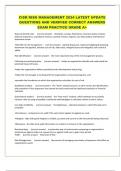CISR RISK MANAGEMENT 2024 LATEST UPDATE
QUESTIONS AND VERIFIED CORRECT ANSWERS
EXAM PRACTICE GRADE A+
Ways to identify risks - (correct answer) Checklists, surveys, flowcharts, Insurance policy reviews,
physical inspections, compliance reviews, contract reviews, experts, loss data analysis and financial
statement review
7 Benefits of risk management - (correct answer) Identify Exposures, Improve budgeting & planning,
determine risk appetite, allocate cost of risk, adds value, mitigate losses and integrates risk control &
safety
Risk Identification - (correct answer) the most important step of the risk management process.
Collecting and analyzing data - (correct answer) •helps an organization identify and understand the
potential impact of losses,
•helps the organization address product/service development and pricing,
•helps the risk manager in working with the organization's insurance programs, and
•provides the foundation on which the organization calculates its cost of risk.
Qualitative analysis - (correct answer) the "what" analysis process, in other words, the identification
and evaluation of loss exposures that cannot be easily measured by traditional statistical or financial
methods.
Quantitative analysis - (correct answer) the "how much" analysis, which attempts to accurately
measure risks by using acceptable, traditional methodologies to calculate relative numeric values.
Loss Data Credibility - (correct answer) •Completeness - statistical analysis is valid if the data set is
complete.
•Consistency - comparisons are valid if the same items (apples to apples) are used.
•Integrity - data with good integrity is reliable, accurate and current to the time period being measured.
•Relevance - the data must yield information on matters of concern to the organization.
Benchmarking - (correct answer) a systematic way of continuously comparing an organization's
performance against others at a given time or against itself over a given time period.
TCOR - (correct answer) Total Cost of Risk
Risk Management - (correct answer) the process of managing uncertainty of exposures that affect an
organizations assets
, 5 steps of risk management process - (correct answer) Identification, analysis, control, financing and
administration
Six general classes of risk - (correct answer) 1. Economic
2. Legal
3. Political
4. Social
5. Physical
6. Juridical
Four Logical Classifications of Exposures - (correct answer) A. Property
B. Human Resources
C. Liability
D. Net Income
Risk Control - (correct answer) Any conscious action or inaction to minimize, at the optimal cost, the
probability, frequency, severity, or unpredictability of loss
Risk Financing - (correct answer) The acquisition of internal and external funds to pay losses at the
most favorable cost.
Risk Financing Techniques - (correct answer) Risk Taking appetite, transfer options, simple transfer
options & loss sensitive transfer options
Risk Administration - (correct answer) the process of planning, implementing, and monitoring the risk
management program
Risk Management Information System - (correct answer) an information system that supports both
the risk team and the organization. This type of software deploys risk management tools in addition to
managing risk data. RMIS can sometimes serve as a customer relationship module, as well.
Four Components of the Total Cost of Risk - (correct answer) Insurance Costs, Retained losses &
ALAE, Risk Management departmental costs and Outside service fees
Pure Risk - (correct answer) A chance of loss or no loss, but no chance of gain.
Speculative Risk - (correct answer) Chance of loss or gain, usually associated with business or
financial risk.
Exposure - (correct answer) a situation, practice, or condition that may lead to an adverse financial
consequence; an activity or asset.
Hazard - (correct answer) a condition that may give rise to a loss from a given peril; physical, moral,
or morale characteristics that increases the likelihood of a loss.
Peril - (correct answer) the cause of loss, such as fire, wind, hail, slip and fall, etc.




